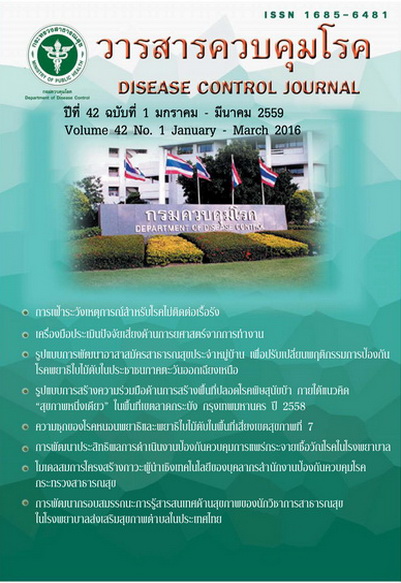A structural equation model of technology personnel leadership for Office of Disease Prevention and Control, Ministry of Public Health
DOI:
https://doi.org/10.14456/dcj.2016.33Abstract
The objectives of this research were to (1) evaluate the level of technology leadership, factors affecting technology leadership of the Office of Disease Prevention and Control, Ministry of Public Health, and compare according to sex, age, and experience; (2) evaluate the goodness-of-fit of the structural equation model of technology leadership of the Office of Disease Prevention and Control which was developed using empirical data; and (3) study the influence of each factor on technology leadership of the Office of Disease Prevention and Control. Samples were 360 personnels of the Office of Disease Prevention and Control, section 1-12 selected using quota sampling and simple random sampling method. Questionnaire with a 5-level rating scale was used as research instrument with a reliability of 0.98. The data collected was analyzed using statistical packed program and LISREL 8.54 program. Statistics used were descriptive and inferential statistics. The research results found that the mean of technology leadership level of the Office of Disease Prevention and Control were at a high level. All factors, namely, technology competence, technology vision, and technology integration, when compared between sex, age, and work experience, were statistically significant indifferent. The structural equation model of information technology leadership of the Office of Disease Prevention and Control by the researcher showed a goodness-of-fit with statistical data as follows: X2 = 14.07, df = 69, GFI = 0.99, AGFI = 0.97, CFI = 1.00, SRMR = 0.019, RMSEA = 0.000, and CN = 902.10. Technology competence had the highest total influence on technology leadership of 0.53, with a statistically significant direct influence of 0.53, and a non-statistically significant indirect influence. This was followed by technology vision, which had a total influence of 0.27, a statistically significant direct influence of 0.36, and a non-statistically significant indirect negative influence. Technology integration had a non-statistically significant total and direct influence. All the three factors can be combined and used to predict 68.00% of the Office of Disease Prevention and Control personnels’ technology leadership. It can be concluded that the improvement of technology leadership of the Office of Disease Prevention and Control personnels can be done by directly improving technology competence.
Downloads
References
สารสนเทศและการสื่อสาร ระยะ พ.ศ. 2554-2563 ของประเทศไทย ICT 2020. กรุงเทพมหานคร: กระทรวงเทคโนโลยีสารสนเทศและการสื่อสาร; 2554.
2. กระทรวงสาธารณสุข, กรมควบคุมโรค. แผนแม่บทเทคโนโลยีสารสนเทศกรมควบคุมโรค. กรุงเทพมหานคร: ศูนย์บริการวิชาการแห่งจุฬาลงกรณ์มหาวิทยาลัย; 2551.
3. รัตติกรณ์ จงวิศาล. ภาวะผู้นำการเปลี่ยนแปลง. กรุงเทพมหานคร: สำนักบริหารทรัพยากรมนุษย์ มหาวิทยาลัยหอการค้าไทย; 2551.
4. Yukl GA. Leadership in organizations. 4th ed. Englewood Cliffs, NJ: Prentice-Hall; 1998.
5. วิโรจน์ สารรัตนะ. การพัฒนาครูและผู้บริหารโรงเรียน : ในกระแสสังคมระยะเปลี่ยนผ่านและการปฏิรูป. วารสารศึกษาศาสตร์ มหาวิทยาลัยขอนแก่น 2547;27:10-21.
6. จันทกานติ์ ตันเจริญพานิช, นิตยา เงินประเสริฐศรี. ทิศทางการพัฒนาภาวะผู้นำภาครัฐของไทยในคริสต์ศตวรรษที่ 21. วารสารสังคมศาสตร์และมนุษยศาสตร์ 2550;33:82-90.
7. บรรจบ บุญจันทร์. โมเดลสมการโครงสร้างภาวะผู้นำเชิงเทคโนโลยีของผู้บริหารสถานศึกษาขั้นพื้นฐาน [วิทยานิพนธ์ปริญญาปรัชญาดุษฎีบัณฑิต] ขอนแก่น: มหาวิทยาลัยขอนแก่น; 2554.
8. Cooper DR, Schindler PS. Business research methods. 9th ed. New York: McGraw - Hill ; 2006.
9. นงลักษณ์ วิรัชชัย. โมเดลลิสเรล สถิติวิเคราะห์สำหรับการวิจัย. พิมพ์ครั้งที่ 3. กรุงเทพมหานคร: สำนักพิมพ์จุฬาลงกรณ์มหาวิทยาลัย; 2542.
10. อังศินันท์ อินทรกำแหง, ทัศนา ทองภักดี. การพัฒนารูปแบบสมรรถนะด้านผู้นำทางวิชาการของอาจารย์ในมหาวิทยาลัยของรัฐ เอกชน และในกำกับของรัฐ. กรุงเทพมหานคร: สถาบันวิจัยพฤติกรรมศาสตร์ มหาวิทยาลัยศรีนครินทรวิโรฒ; 2549.
11. Ho J. Technology leadership. Singapore: Educational Technology Division, Ministry of Education; 2006.
12. Seay DA. A study of the technology leadership of Texas high school principals [ doctoral dissertation]. Denton, Texas: University of North Texas; 2004.
13. Persaud B. School administrators’ perspective on their leadership role in technology integration [doctoral dissertation]. Minneapolis, Minnesota: Walden University; 2006.
14. Miller ML. A mixed-methods study to identify aspects of technology leadership in elementary schools [doctoral dissertation]. London: Regent’s University; 2008.
15. Keller-Raber CA. Media literacy skills: Factors influencing successful student mastery. Tallahas¬see, Florida: The Florida State University; 1995.
16. Reinke CE. Development and validation of a principal’s staff development sourcebook on leadership for redesigning schools with technology [doctoral dissertation]. Manhattan, Kansas: Kan¬sas State University; 1997.
Downloads
Published
How to Cite
Issue
Section
License
Articles published in the Disease Control Journal are considered as academic work, research or analysis of the personal opinion of the authors, not the opinion of the Thailand Department of Disease Control or editorial team. The authors must be responsible for their articles.






